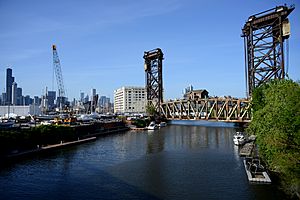Canal Street railroad bridge facts for kids
Quick facts for kids Canal Street railroad bridge |
|
|---|---|

Southbound Amtrak train crossing the South Branch Chicago River
|
|
| Coordinates | 41°51′20.3″N 87°38′13.2″W / 41.855639°N 87.637000°W |
| Crosses | Chicago River |
| Locale | Chicago |
| Official name | Pennsylvania Railroad, Canal Street Railroad Bridge |
| Heritage status | Chicago Landmark |
| Characteristics | |
| Design | vertical-lift bridge |
| Longest span | 272.8 feet (83.1 m) |
| History | |
| Designer | Waddell & Harrington |
| Construction begin | September 4, 1913 |
| Construction end | July 30, 1914 |
The Canal Street railroad bridge is a special kind of bridge in Chicago, Illinois. It's a vertical-lift bridge, which means a part of it can move straight up and down. This bridge crosses the South Branch of the Chicago River.
It's also known as the Pennsylvania Railroad bridge. On December 12, 2007, this amazing bridge was named a Chicago Landmark. This means it's an important historical place in the city!
Contents
Building the Canal Street Bridge
Why was a new bridge needed?
The Canal Street bridge you see today wasn't the first one in this spot. Before it, there was an older bridge called a swing bridge. A swing bridge opens by swinging its middle part to the side, like a gate.
The old bridge only had two tracks for trains. The Pennsylvania Railroad needed a new, more modern bridge. This new bridge would also have two tracks, but it would be much better.
How was the bridge built?
Building the new bridge was tricky! Workers had to keep the old swing bridge working. This was important so trains could still cross the river. Also, boats needed to pass freely on the river.
So, the builders came up with a clever plan. They decided to build the new bridge above the old one! This way, the old bridge could still be used while the new one was being put together.
The company Waddell & Harrington designed this smart bridge. Another company, Pennsylvania Steel Company, built and put it all together.
Starting construction in 1913
Work on the south tower of the bridge began on September 4, 1913. The bridge has two tall towers, each about 185-foot (56 m) high.
Once the towers were finished, workers built a special support structure. This structure helped them build the main part of the bridge. They built this main section high up, about 130 feet (40 m) above the river. The entire bridge was made from strong steel and other metals.
How the Bridge Works
Moving the bridge for boats
The Canal Street bridge carries two railroad tracks. These tracks cross the Chicago River at a slight angle.
When it was new, the main part of the bridge could be lifted 111 feet (34 m) high. This amazing lift took only about 45 seconds! This quick lifting allowed boats to pass underneath easily.
Busy trains and river traffic
By 1916, the bridge was very busy. About 300 trains crossed it every single day! And it was lifted for river boats about 75 times a day. Imagine how much work that was!
Cool Facts About the Bridge
- When it was finished in 1914, the main part of the bridge weighed 1500 tons. That made it the heaviest vertical-lift bridge in the whole United States at that time!
- This bridge is special because it's the only vertical-lift bridge that crosses the Chicago River. All the other movable bridges on the river are different types.
Images for kids



